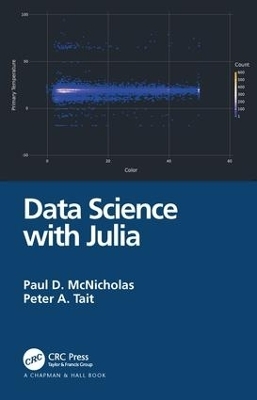
Data Science with Julia
CRC Press (Verlag)
978-1-138-49998-0 (ISBN)
"This book is a great way to both start learning data science through the promising Julia language and to become an efficient data scientist."- Professor Charles Bouveyron, INRIA Chair in Data Science, Université Côte d’Azur, Nice, France
Julia, an open-source programming language, was created to be as easy to use as languages such as R and Python while also as fast as C and Fortran. An accessible, intuitive, and highly efficient base language with speed that exceeds R and Python, makes Julia a formidable language for data science. Using well known data science methods that will motivate the reader, Data Science with Julia will get readers up to speed on key features of the Julia language and illustrate its facilities for data science and machine learning work.
Features:
Covers the core components of Julia as well as packages relevant to the input, manipulation and representation of data.
Discusses several important topics in data science including supervised and unsupervised learning.
Reviews data visualization using the Gadfly package, which was designed to emulate the very popular ggplot2 package in R. Readers will learn how to make many common plots and how to visualize model results.
Presents how to optimize Julia code for performance.
Will be an ideal source for people who already know R and want to learn how to use Julia (though no previous knowledge of R or any other programming language is required).
The advantages of Julia for data science cannot be understated. Besides speed and ease of use, there are already over 1,900 packages available and Julia can interface (either directly or through packages) with libraries written in R, Python, Matlab, C, C++ or Fortran. The book is for senior undergraduates, beginning graduate students, or practicing data scientists who want to learn how to use Julia for data science.
"This book is a great way to both start learning data science through the promising Julia language and to become an efficient data scientist."
Professor Charles Bouveyron
INRIA Chair in Data Science
Université Côte d’Azur, Nice, France
Paul D. McNicholas is the Canada Research Chair in Computational Statistics at McMaster University, where he is a Professor in the Department of Mathematics and Statistics. Peter Tait is a Ph.D. student at the Department of Mathematics and Statistics at McMaster University. Prior to returning to academia, he worked as a data scientist in the software industry, where he gained extensive practical experience.
Chapter 1
Introduction
DATA SCIENCE
BIG DATA
JULIA
JULIA PACKAGES
R PACKAGES
DATASETS
Overview
Beer Data
Coffee Data
Leptograpsus Crabs Data
Food Preferences Data
x Data
Iris Data
OUTLINE OF THE CONTENTS OF THIS
MONOGRAPH
Chapter 2
Core Julia
VARIABLE NAMES
TYPES
Numeric
Floats
Strings
Tuples
DATA STRUCTURES
Arrays
Dictionaries
CONTROL FLOW
Compound Expressions
Conditional Evaluation
Loops
Basics
Loop termination
Exception Handling
FUNCTIONS
Chapter 3
Working with Data
DATAFRAMES
CATEGORICAL DATA
IO
USEFUL DATAFRAME FUNCTIONS
SPLIT-APPLY-COMBINE STRATEGY
QUERYJL
Chapter 4
Visualizing Data
GADFLYJL
VISUALIZING UNIVARIATE DATA
DISTRIBUTIONS
VISUALIZING BIVARIATE DATA
ERROR BARS
FACETS
SAVING PLOTS
Chapter 5
Supervised Learning
INTRODUCTION
CROSS-VALIDATION
Overview
K-Fold Cross-Validation
K-NEAREST NEIGHBOURS CLASSIFICATION
CLASSIFICATION AND REGRESSION TREES
Overview
Classification Trees
Regression Trees
Comments
BOOTSTRAP
RANDOM FORESTS
GRADIENT BOOSTING
Overview
Beer Data
Food Data
COMMENTS
Chapter 6
Unsupervised Learning
INTRODUCTION
PRINCIPAL COMPONENTS ANALYSIS
PROBABILISTIC PRINCIPAL COMPONENTS
ANALYSIS
EM ALGORITHM FOR PPCA
Background: EM Algorithm
E-step
M-step
Woodbury Identity
Initialization
Stopping Rule
Implementing the EM Algorithm for
PPCA
K-MEANS CLUSTERING
MIXTURE OF PPCAS
Model
Parameter Estimation
Illustrative Example: Coffee Data
Chapter 7
R Interoperability
ACCESSING R DATASETS
INTERACTING WITH R
EXAMPLE: CLUSTERING AND DATA REDUCTION
FOR THE COFFEE DATA
Coffee Data
PGMM Analysis
VSCC Analysis
EXAMPLE: FOOD DATA
Overview
Random Forests
| Erscheinungsdatum | 20.12.2018 |
|---|---|
| Verlagsort | London |
| Sprache | englisch |
| Maße | 138 x 216 mm |
| Gewicht | 336 g |
| Themenwelt | Mathematik / Informatik ► Informatik ► Datenbanken |
| Mathematik / Informatik ► Informatik ► Programmiersprachen / -werkzeuge | |
| Mathematik / Informatik ► Mathematik ► Computerprogramme / Computeralgebra | |
| Mathematik / Informatik ► Mathematik ► Wahrscheinlichkeit / Kombinatorik | |
| ISBN-10 | 1-138-49998-6 / 1138499986 |
| ISBN-13 | 978-1-138-49998-0 / 9781138499980 |
| Zustand | Neuware |
| Informationen gemäß Produktsicherheitsverordnung (GPSR) | |
| Haben Sie eine Frage zum Produkt? |
aus dem Bereich


